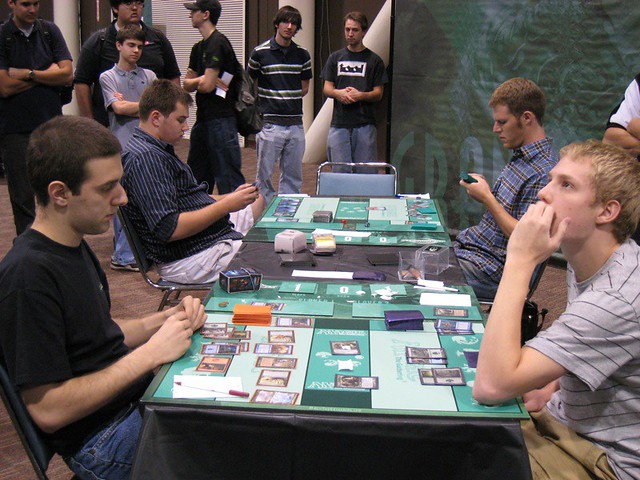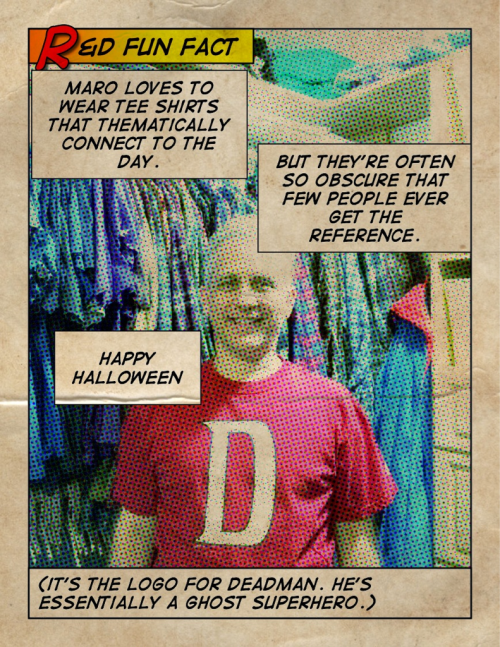The first five principles were:
- Goal(s). Easiest part for educational games.
- Rules.
- Interaction.
- Catch-Up. Most subtle, maybe because so many games lack this.
- Inertia. Hard for teachers.
6. Surprise. The game should have some unpredictability for players.
To me, this connects strongly to Interaction and Catch-Up. One way to get surprise is hidden information - which often can contribute to interaction amongst players. Information can be hidden from both or the players can hide it from each other. The new game Flip Out has a good element of this with two sided cards of which each player sees different sides. A benefit for math and literacy is that this makes inference a part of the game.
The other easy way to add surprise is random events - which can contribute to making catch up possible. The only thing that makes Monopoly playable is the dice rolling. In Euchre, no matter how good you are, you need cards to play. The math benefit is the addition of probability, even if informal, to game play. It's no surprise that the two most common game pieces are dice and cards.
7. Strategy.
Interesting to me that this is so low on the list, which makes me wonder what he was ordering them to achieve.
 |
| by mhuang @ Flickr |
There's a natural tension between Surprise and Strategy. If things are too random, strategy loses all impact. If things aren't random at all, it is chess or go. Both great games, obviously, but also both games that struggle with Catch-Up and Inertia for many players. Plug for Magic: the balance of these two elements is a large part of what makes the game so bloody amazing. Also applies to Bridge, to a lesser extent. (Yes, I'm claiming Magic > Bridge.)
8. Fun.
I struggle with this. Because I find interaction, surprise and strategy so engaging, I love games in general. I'll play anything. But what makes a game fun to kids is often a surprise to me. It's not uncommon for me to take a game to kids, and let them add the context. I wrote about this a bit with my Division into Decimals game. Games like Decimal Point Pickle and Power Up had this in spades. Probably this is the difference between a game being good, and the game being a smash hit.
To some extent I think the last two principles are really subcategories of this one. Did they get pulled out to make ten or - more likely - is there something I'm missing that makes them truly distinct?
9. Flavor.
10. Hook.
Flavor is about the context and setting for your game, which heavily influences the fun aspect for players, in my experience. At least on entry, and Mark connects this to the barrier or entry cost to your game. The other principles determine long term fun. In our house, this gets us to play a game fr the first time, but won't sustain interest. One neat point he makes about flavor, though, is how it can influence design. My youth Bible study is making a return of the Lord card game based on the 10 bridesmaids parable. (Yes, really.) But the context for the game is inspiring a four horseman of the apocalypse feature that will definitely add interest to the game. Probably shouldn't have shared this story.
The idea of constructive flavor reminds me of my colleague Jacqui Melinn talking about integrated units. A marine biology integrated unit is not when you put your math practice problems on a whale-themed sheet, it's when your questions about whales require math to think about and solve. Good flavor isn't an add on, but supports the game mechanics. For a math game, this gets at the structure of the game supporting the mathematical objective. Cheap flavor is the hallmark of flashcard/drill math games. "Look you're doing lots of multiplication, but it's on a baseball diamond!"
Hook is what gets people to try your game. This is less important in educational games to me as we have a built-in market (students), but I'm also not trying to sell my games to a publisher. (So maybe my hook is that my games are free?) However it does remind me of Dan Meyer talking about a hook for a lesson, and could well be linked to engagement. I just don't know how to tease it out from flavor and fun. Maybe hook is a measure of whether the game has things that make you wonder?
My Nine
Looking over the list, I think I'd order them more like the following to get at my process.
- Goal(s). Design starts with objectives.
- Structure. (Not in his list!) What is the essential nature of your set of learning objectives and how can that show up in the game?
- Strategy. These three have to go into the primary design phase as well, or the game will just not have them.
- Interaction.
- Surprise.
- Catch-Up. As you start to playtest, these two are important to attend to for good design.
- Inertia.
- Rules. For me this comes late; kind of a synthesis step as you think about how to communicate the game. It will often result in design revision, though.
- Context: Fun-Flavor-Hook. To me this can't really be evaluated fully till you're out with the intended audience. You need a first take on this before that, but should be open to major changes in this area.
Images: All Magic: the Gathering stuff is very heavily (c)'d by Hasbro.








No comments:
Post a Comment